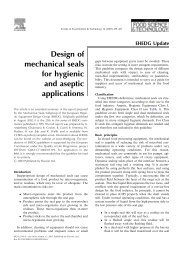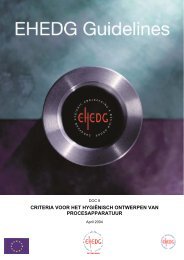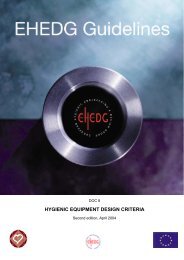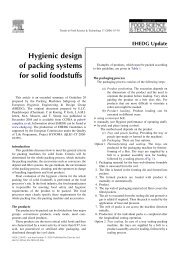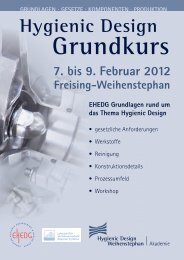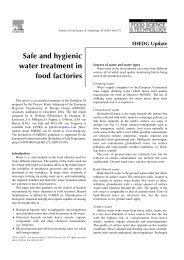Yearbook 2013/2014 - ehedg
Yearbook 2013/2014 - ehedg
Yearbook 2013/2014 - ehedg
Create successful ePaper yourself
Turn your PDF publications into a flip-book with our unique Google optimized e-Paper software.
European Hygienic Engineering & Design Group<br />
New developments for upgrading stainless steel to<br />
improve corrosion resistance and increase equipment<br />
hygiene<br />
Siegfried Piesslinger-Schweiger, POLIGRAT GmbH, 81805 Munich, Germany, e-mail: petra.ressmann@poligrat.de,<br />
www.poligrat.de<br />
New developments enable the upgrading of stainless steel to<br />
improve the corrosion resistance of manufacturing equipment<br />
and components. Unlike the state-of-art techniques that use<br />
higher alloyed steel to produce corrosion-resistant equipment<br />
and components, new methods have been developed<br />
that can be applied as final treatments after production<br />
and elevate the passive layers independently from the<br />
underlying metallic base. One of these methods is based<br />
on a significant increase of the chrome/iron ratio within the<br />
passive layers by extraction of iron and iron oxides, leaving<br />
primarily chrome oxide. The second is a heat treatment that<br />
changes the structure and thickness of the passive layer.<br />
The latter application can be utilised on all types of finishes<br />
and in nearly all commonly used alloys.<br />
These new methods result in a substantial increase of the<br />
resistance against any type of corrosion. They also allow an<br />
effective restoration of corroded surfaces, and with regular<br />
application, can maintain corrosion resistance even in<br />
cases in which stainless steel is not long-term resistant. The<br />
treatments also can be applied to scale and heat discoloration<br />
without pre-treatment, which could widely replace pickling or<br />
mechanical descaling.<br />
Since these methods are based on a treatment with a waterbased<br />
solution of special organic compounds, they are<br />
biodegradable, environmentally friendly, and produce no<br />
fumes or nasty smells. The new methods also allow selection<br />
of the best alloy and structure in terms of hardness, strength<br />
and weight. They open a wide and commercially important<br />
potential for additional applications of stainless steel.<br />
Basics of corrosion-resistant stainless steel<br />
According to the state of the art, the corrosion resistance<br />
of stainless steel is considered a secondary property<br />
of alloy and structure. To increase corrosion resistance<br />
it is necessary to select a higher alloy quality. To meet<br />
the objectives of development a fundamentally different<br />
approach to stainless steel and its functional behaviour is<br />
necessary.<br />
Stainless steel is a composite consisting of a metallic base<br />
and an oxidic cover layer, and the passive layer is similar to<br />
aluminium and titanium. The metallic base determines the<br />
material’s mechanical, electric and magnetic properties and<br />
provides the metals for the formation of the passive layer.<br />
The passive layer determines most of its other properties,<br />
including corrosion resistance. As soon as passive layers<br />
are locally damaged, local corrosion of the metallic base<br />
occurs, such as pitting corrosion, crevice corrosion, Ironinduced<br />
corrosion, stress corrosion cracking (SCC), and<br />
more.<br />
Passive layers completely and densely cover the surface<br />
of stainless steel as long as it does not corrode. Passive<br />
layers are 10 to 15 nm thick and are formed by the reaction<br />
of the metallic base with oxygen from the environment.<br />
They primarily consist of chrome oxides and iron oxides.<br />
Additionally, they contain metallic chrome and iron, and<br />
eventually, other metals like nickel and molybdenum.<br />
Passive layers on stainless steel are not insulators like<br />
the oxides on aluminium and titanium. They are crystalline<br />
semiconductors with all the special properties of these<br />
materials. Thus, the approach to understanding corrosion on<br />
stainless steel should include semiconductor physics.<br />
The ratio of chrome oxides to iron oxides (chrome/iron<br />
ratio) typically is within the range of 0.8 to 2.0. The higher<br />
this ratio, the better the corrosion resistance. That means,<br />
that chrome oxides increase and iron oxides reduce the<br />
corrosion resistance.<br />
Methods to increase corrosion resistance<br />
To improve the corrosion resistance of stainless steel two<br />
methods are promising success. The first is to improve the<br />
chrome/iron ratio within the passive layer and the second is<br />
to improve the crystalline structure.<br />
Conventional state-of-art method. According to the current<br />
state-of-the-art approach, the method for raising the chrometo-iron<br />
ratio within passive layers consists of reducing the<br />
concentration of iron in the metallic base and increasing the<br />
concentration of chrome, and eventually nickel, in the alloy.<br />
This secondary effect leads to a higher chrome/iron ratio<br />
in the passive layers. The structure of passive layers is not<br />
influenced. The concentration of alloying elements besides<br />
iron is only needed within a surface layer of less than 10-<br />
nm thickness to provide the metal for the formation of the<br />
passive layer.<br />
There are a few downsides to the conventional method of<br />
producing corrosion-resistant stainless steel. The adaption<br />
of total alloy and structure to form the passive layer<br />
substantially determines the other properties of the alloy.<br />
A potential consequence of this is that expensive details<br />
of construction like wall thickness and weldability must be<br />
adapted. The adaption of alloy and structure to achieve<br />
gains in the level of corrosion resistance can only occur in<br />
the production of steel. This means that a great number of<br />
qualities of stainless steel must be produced and be available<br />
as semi-finished product, which reduces the flexibility in the<br />
material’s application and increases costs.



